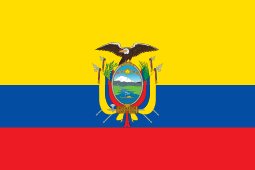Tulcán
Tulcán (Spanish pronunciation: [tulˈkan]) is the capital of the province of Carchi in Ecuador and the seat of Tulcán Canton. The population of the city of Tulcán was 47,359 in the 2001 census and 53,558 in the 2010 census.[1] Tulcán is known for its hot springs, deep wells, 3-acre topiary garden cemetery, the most elaborate topiary in the New World,[2] created with Cupressus sempervirens by José Maria Azael Franco in 1936. The city is the highest in Ecuador, at 2,950 m (9,680 ft) above sea level.
- "Tulcan" is also an alternative spelling of tulchan
Tulcán | |
|---|---|
 Flag | |
| Nickname(s): "Heir of the Sun, and Earth" | |
 Tulcán | |
| Coordinates: 0°48′42″N 77°43′7″W | |
| Country | Ecuador |
| Province | Carchi |
| Government | |
| • Mayor | Julio Robles |
| Area | |
| • City | 138.75 km2 (53.57 sq mi) |
| • Metro | 1,828.17 km2 (705.86 sq mi) |
| Elevation | 2,980 m (9,780 ft) |
| Population (2010 census) | |
| • City | 60,403 |
| • Density | 440/km2 (1,100/sq mi) |
| • Metro | 86,498 |
| Demonym(s) | Tulcaneño,-a |
| Time zone | UTC−5 |
| Postal code | EC040101-2 |
| Area code(s) | (+593) 6 |
| Climate | Csb |
| Website | www |
Etymology
The name is a Spanish derivation of the indigenous peoples' original name Hul-Can, which means "Warrior".[3]
History
The first known history of the aboriginal occupants of this land begins with the failed Incan conquests. Tulcán sits within the northernmost outpost of the Inca Empire, which according to Spanish chroniclers, was the Rumichaca Bridge, located 7 kilometres (4.3 mi) from Tulcàn and the present-day border with Colombia.[4]
The Spanish, seeking gold, became interested in the Quillasinga (the name given to the land), meaning "Gold Noses".[5] Quillasinga was named without distinction of the ethnic occupants including the Pastos. Upon assuming the sovereignty for the Spanish crown, the territory was divided into provinces: Quillasinga road to Quito, Quillasinga road to Popayan, Quillasinga road to Almaguer, and Quillasinga road of the mountains. Tulcan's foundation is said to have been on June 11, 1535. With the arrival of colonists and further Spanish conquistadors, its growth increased and immediately passed to serve the Township of Otavalo, until 1600 when it passed to the township of Ibarra.
During the colonial age it remained under the authority of the Real Audiencia de Quito, in which it increased its economic importance, until it became the most significant locality in the region.[3]
Independence
Independence movements and proclamations sparked through the region. The independence movement in Carchi was led by Alejandro Ruano, Antonio Baca, Cecilio Arciniegas, Esteban Baca, Leandro Campiño, José María Pava, Antonio Rueda, and Ramón Montenegro. On April 14, 1814 with charges of conspiracy of fighting for independence, these men were shot in Bolivar. The population continued its rebellion and in 1820, it ratified the Declaration of Independence of 9 de Octubre. Upon Ecuador becoming a republic, Tulcán retained its importance because it became a border town.[3]
Proximity to Colombia
Tulcán is just 7 km (4.3 mi) from the Colombian border; the international bridge at Rumichaca which bridges the Carchi River is shared by the two countries. Tulcán is bounded on the north by the municipality of Ipiales (Colombia), on the south by the San Pedro de Huaca Canton, to the east by the Amazonian provinces of Sucumbios and to the west by the coastal province of Esmeraldas.
This city is known for its civic culture and modern business, similar to that of Colombia because of its proximity to and significant trade with that country.
Climate
Tulcán features a Mediterranean climate (Csb) under Köppen climate classification.
| Climate data for Tulcán | |||||||||||||
|---|---|---|---|---|---|---|---|---|---|---|---|---|---|
| Month | Jan | Feb | Mar | Apr | May | Jun | Jul | Aug | Sep | Oct | Nov | Dec | Year |
| Average high °C (°F) | 16.6 (61.9) |
16.6 (61.9) |
16.6 (61.9) |
16.8 (62.2) |
16.7 (62.1) |
15.9 (60.6) |
15.3 (59.5) |
15.6 (60.1) |
16.4 (61.5) |
17.0 (62.6) |
17.1 (62.8) |
16.8 (62.2) |
16.5 (61.6) |
| Average low °C (°F) | 6.4 (43.5) |
6.6 (43.9) |
6.7 (44.1) |
7.0 (44.6) |
6.8 (44.2) |
6.3 (43.3) |
5.6 (42.1) |
5.5 (41.9) |
5.8 (42.4) |
6.4 (43.5) |
6.5 (43.7) |
7.4 (45.3) |
6.4 (43.5) |
| Average rainfall mm (inches) | 75 (3.0) |
80 (3.1) |
92 (3.6) |
106 (4.2) |
78 (3.1) |
58 (2.3) |
37 (1.5) |
37 (1.5) |
51 (2.0) |
113 (4.4) |
120 (4.7) |
94 (3.7) |
941 (37.1) |
| Source: [6] | |||||||||||||
Transportation
Tulcán is very well connected in terms of land and air transport: the Panamerican Highway and Luis A. Mantilla airport are located nearby.
See also
- Ecuador-Colombia relations
References
- "Tulcan, Ecuador", https://www.citypopulation.de/php/ecuador.php?cityid=040150, accessed 13 Jul 2017
- According to Dr Edgar Anderson, director of the Missouri Botanical Garden, quoted in Charles B. Heiser, Jr., "Topiary in Tulcán", American Horticulturist, April 1985:28-31.
- "Enciclopedia del Ecuador - Efrén Avilés Pino". enciclopediadelecuador.com. Retrieved 2014-01-25.
- Almeida Reyes, Dr. Eduardo (2015), "El Camino del Inca en las Sierra Norte del Ecuador y su Valoracion Turistica", Revista de Invetigacion Cientifica, No, 7, pp. 75-87
- "EL TERRITORIO QUILLACINGA I - banrepcultural.org". banrepcultural.org. Retrieved 2014-01-25.
- "Climate Data".
External links
| Wikimedia Commons has media related to Tulcán. |
